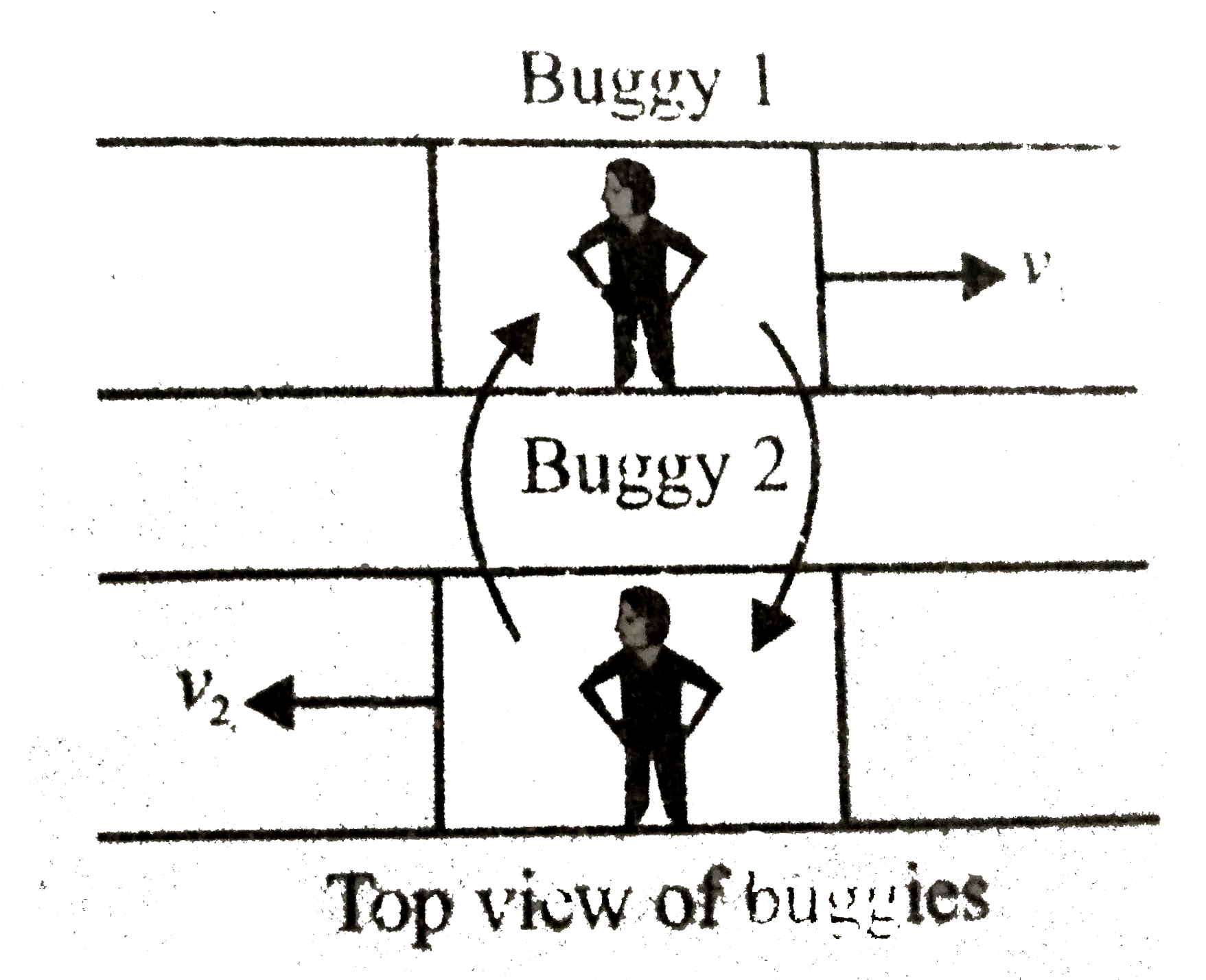Two identical buggies 1 and 2 with one man in each move without friction due to inertia along the parallel rails toward each other. When the buggies get opposite each other, the men exchange their places by jumping in the direction perpendicular to the motion direction. As a consequence, buggy 1 stops and buggy 2 keeps moving in the same direction, with its velocity becoming equal to v. Find the initial velocities of the buggies v1 and v2 if the mass of each buggy (without a man) equals M and the mass of each man m.
The correct Answer is:v1=mvM−m,v2=MvM−m
Step by step video, text & image solution for Two identical buggies 1 and 2 with one man in each move without friction due to inertia along the parallel rails toward each other. When the buggies get opposite each other, the men exchange their places by jumping in the direction perpendicular to the motion direction. As a consequence, buggy 1 stops and buggy 2 keeps moving in the same direction, with its velocity becoming equal to v. Find the initial velocities of the buggies v_1 and v_2 if the mass of each buggy (without a man) equals M and the mass of each man m. by Physics experts to help you in doubts & scoring excellent marks in Class 11 exams.
Topper's Solved these Questions
- BOOK - NN GHOSHCHAPTER - LAWS OF MOTION, FREE BODY DIAGRAMEXERCISE - Exercise (A)27videos
LAWS OF MOTION, FREE BODY DIAGRAM
- BOOK - NN GHOSHCHAPTER - KINETIC THEORY OF GASESEXERCISE - All Questions24videos
KINETIC THEORY OF GASES
- BOOK - NN GHOSHCHAPTER - MOMENT, TORQUE, EQUILIBRIUM OF BODIESEXERCISE - Exercises33videos
MOMENT, TORQUE, EQUILIBRIUM OF BODIES
Similar Questions
Two identical buggies 1 and 2 with one man in each move along parallel rails. When the buggies are opposite to each other, the men jump in a direction perpendicular to the direction of motion of buggies, so as to exchange their places. As a consequence, buggy 1 stops and buggy 2 keeps moving in the same direction with its final velocity v. Find the initial velocities v1 and v2 of buggies. Mass of each buggy (without man) equals M mass of each man is ignore frictional effects anywhere and the buggies are constrained to move along the rails only.
 View Solution
View SolutionWhy two boats moving in parallel directions close to each other get attracted?
View Solution
Knowledge Check
- Question 1 - Select One
A beam of electrons and protons move parallel to each other in the same direction, then they
Ado not exert any force on each otherBrepel each otherCattract each otherDget rotated to be perpendicular to each other - Question 2 - Select One
A beam of electrons and protons move parallel to each other in the same direction, then they
AAttract each otherBRepel each otherCNo relationDNeither attract nor repel - Question 3 - Select One
The two linear parallel conductors carrying currents in the opposite direction…………………each other.
AIf both assertion and reason are true and reason is the correct explanation of assertion.BIf both assertion and reason are true but reason is the correct explanation of assertion.CIf assertion is true but reason is falseDIf both assertion and reason are false.
Two row boats moving parallel to each other and near by, are pulled towards each other. Explain.
View SolutionWhy two boats moving in parallel directions close to each other get attracted?
View SolutionIn how much time trains will pass each other if they are moving in the same direction.
View SolutionTwo parallel wires carrying current in the same direction attract each other while two beams of electrons travelling in the same direction repel each other. Why?
View SolutionTwo, current carrying conductors are placed parallel to each other. Explain if there is attraction or repulsion between them when the current flowing through them is in the.
(i) same direction
(ii) opposite direction.View Solution

